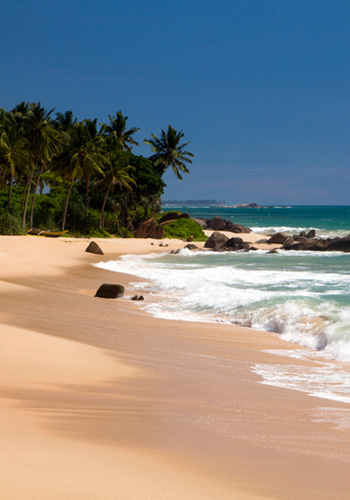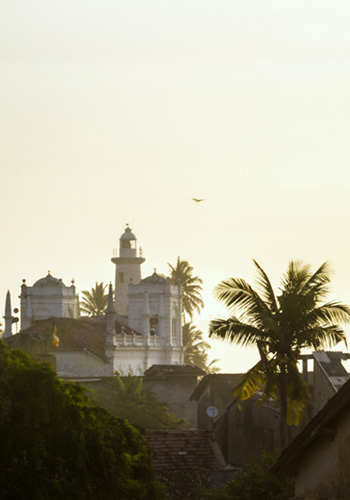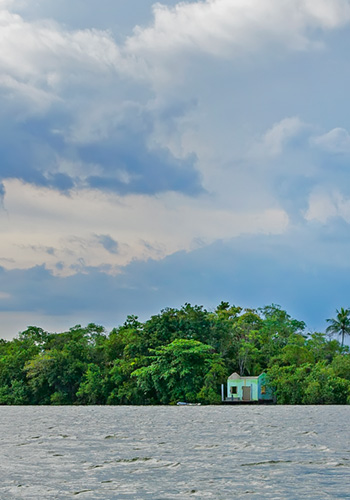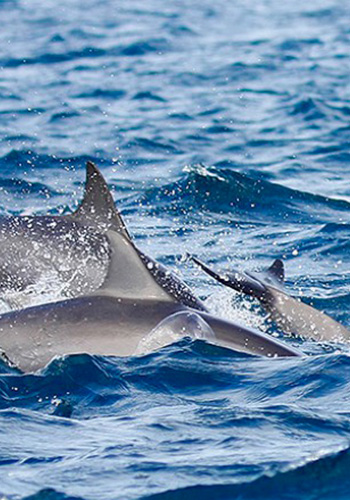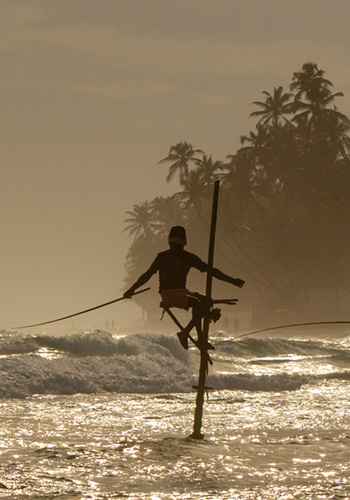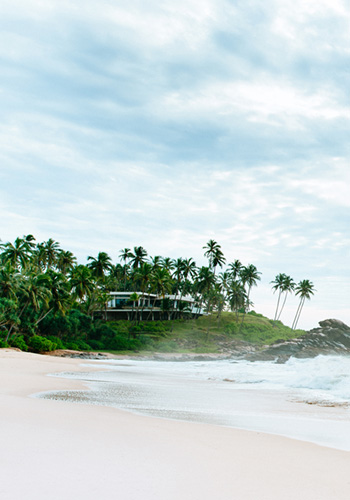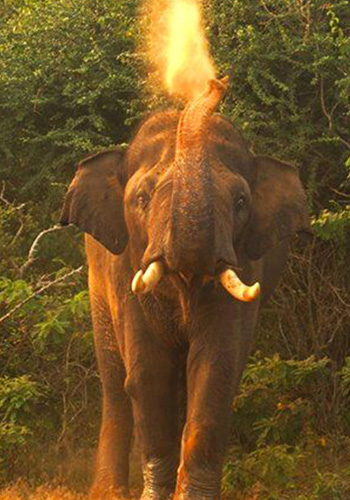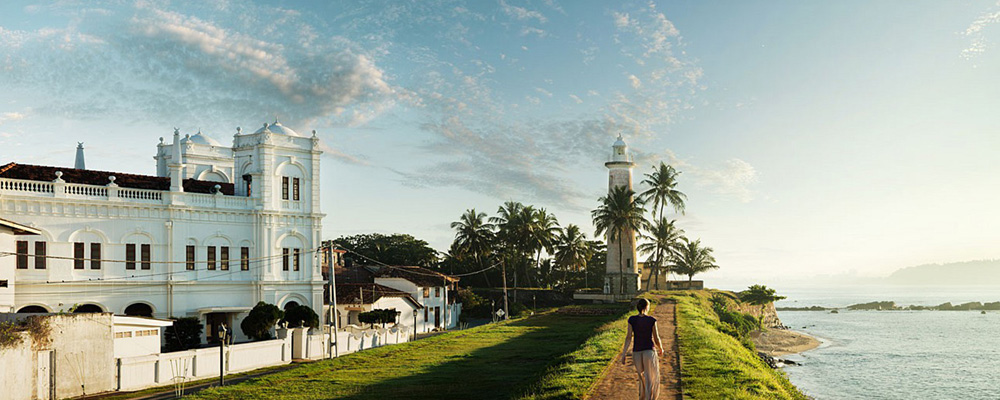
Galle and the South West
The South is every bit as sultry and enticing as the iconic palm fringed coast line images make it out to be, and even more so. A glorious shoreline of curvy golden sand beaches, while along the coast and interior vivid greens of paddy and coconut groves and sleepy villages dominate the landscape. The region is a delight to explore and no two beaches are ever the same. Galle Fort, an utterly captivating and fortified town, is undoubtedly the South’s cultural and historical highlight, with a very cosmopolitan vibe, with trendy shops and cafes, as well as some beautifully restored Dutch era villas, which now house private villas and boutique hotels. These exist side by side by the original inhabitants of the fort who have inhabited the fort for generations as traders. The Fort hosts the excellent annual Galle Literature Festival which draws international names as well as homegrown authors and poets. The further south you go, the less touristic and crowded the beaches become. There is excellent chance of sighting of blue whales off Mirissa, and this coast sees 5 of the 7 species of turtle nestling on its shorelines.
Balapitiya
Balapitiya is a well-known fishing village located 80km south of Colombo. The Madu River falls into the Indian Ocean in the vicinity of Balapitya, and the area is home to some exotic mangroves. The lagoon is great for canoeing and paddle-boarding and a number of other water sports options are available the area.
Though it’s nowhere near as big as some of the other, more popular beach destinations in the island, Balapitiya is fast emerging as a favourite among those seeking the quiet solitude of a coastal fishing village. The Madu River is well regarded among locals as one of the more pristine rivers in Sri Lanka, and is the perfect spot for a quiet dip. One can canoe here for hours on end on the perfectly still waters and the serenity offered by the river and its surroundings have figured prominently in local popular culture.
Bentota
Located just 65km south of Colombo, Bentota is a popular destination for waters sports enthusiasts. The Bentara river falls into the Indian Ocean here, and the perfectly still waters of the river and lagoon are ideal for a number of activities including paddle-boarding, water skiing and jet skiing. The sea itself is well suited for body-surfing, swimming, snorkeling and even scuba diving in the unusually warm waters off Bentota Bay.
PADI-certified diving instructors are available at the beach throughout the season. Canoe Rock near the Bay is a popular spot for divers looking to explore the coral reefs in this area. Bentota is also great for night diving for the more adventurous among you.
Boat rides are available to explore both the lagoon and the mangroves of the Bentara River. Bentota’s wide, golden sandy beach is fringed with 4-5 star hotels run by some of the bigger local hotel chains, as well as smaller boutique properties.
GALLE
The Galle Fort, built by the Portuguese in the 16th century and subsequently fortified by the Dutch in the mid-1600s, is a UNESCO World Heritage site inside which sits the old port city of Galle. With its cobbled streets and quaint little cottage-like dwellings and boutique hotels, the Galle Fort is the picture of romance, to say nothing of its mighty ramparts overlooking the Indian Ocean.
The world renowned Galle Literary Festival takes place here, attracting internationally known authors every year. The Galle Fort boasts a number of high-end and midrange restaurants, and budget and luxury hotels litter the landscape. The old lighthouse in one of the rampart corners makes for a gorgeous backdrop for photography. History buffs can stop by the National Maritime History Museum located inside the Fort premises.
Apart from the Fort, Galle is also famous for its natural harbour, and the spectacular beaches in its vicinity, such as Jungle Beach and Unawatuna. Rumassala Hill, which towers above Jungle Beach, is home to an ancient temple and the hill’s mythological origins can be traced back to the Indian epic the Ramayanaya. Galle is located 119km from Colombo.
Koggala
Though Koggala is a coastal town with its own gorgeous and reef-protected beach, it is probably best known for its lagoon and lake. With a surface area of over 7 square kilometres, and a water depth ranging from 1 to 3.7 metres, the rain-fed Koggala Lagoon is paddle boarding paradise. The lagoon is littered with eight ecologically rich islets – one of which (the famous Madol Doowa) is the subject of a popular Sri Lankan novel bearing its name. The author, Martin Wickramasinghe, a pioneering literary giant, was born in Koggala in 1890. Known for its rich biodiversity and its lush mangrove swamps, Koggala attracts ecologically conscious travellers from around the world. At least ten species of mangrove found here are endemic to Sri Lanka. Seven of the eight islands can be reached by boat or kayak. About five kilometres from the town is a unique place of worship: the Katuluva Purvarama Viharaya which dates back to the 13th century. What makes this temple unique are the images of various European figures – including Queen Victoria herself – found among the mostly Kandyan-style frescos adorning its walls.
Mirissa
Mirissa is no longer the sleepy coastal village it once was, yet, in many ways it feels as though it still is. Mirissa Bay is arguably one of the best beaches in Sri Lanka, drawing hundreds of tourists – mainly from the West – in the peak November-January season. Located 150km south of Colombo, Mirissa is a tourism hotspot with an active night life. The New Year’s Eve parties here, in particular, can and do get pretty wild. The beach stretches for about a kilometer, and on a good day is wide enough to play football on. On the left side of the bay is smaller cove protected by a reef, making it ideal for a quick dip. While it’s no Arugam Bay, Mirissa is also a highly recommended surfing spot for beginner and intermediate surfers. The beach is dotted with a long line of restaurants that cater to hungry and thirsty tourists. Despite all this, Mirissa still hasn’t lost its old, “undiscovered” feel and is still one of the best vacation spots on the south coast of Sri Lanka. It’s also the base for most of the south coast’s whale watching operators, with a resident population of dolphins and Blue Whales, and offers one of the best places in the world to see these gentle giants.
Talpe
Talpe is an emerging tourism hotspot. Offering spellbinding sunsets, the unusually long stretch of beach here with its swimming pool-like basin of a sea, it is the ideal holiday destination for beach lovers. Because it’s still being discovered by the industry, the beach remains largely unspoiled and is a great spot for a quiet dip or a nice, long, uninterrupted nap on a deckchair outside its one (and highly recommended) beach restaurant, Wijaya Beach. Located just a couple of kilometres south of the better known Unawatuna Bay, Talpe is just a 15-minute tuk ride from Galle town – even less from the Southern Expressway exit and is one of the most easily accessible beaches in the south. There are a number of activities available for those looking to do more than just wade the breathtaking waters. There is snorkeling – watch out for those giant turtles who make regular appearances – kayaking and, best of all, swinging on a rope hanging from a tall coconut tree inclined over the water. It’s an exhilarating experience to swing across the tree and dive feet-first into the inviting water below. Keep an eye out for the iconic stilt fishermen who can be seen perched precariously all along this stretch of coastline.
Tangalle
Tangalle is a picture postcard brought to life. The golden sands that seem to stretch on for miles are kissed by a gentle and endless surf emanating from the depths of the Indian Ocean. Underneath the turquoise waters is a massive coral-reef encircling the bay area which protects the beach from the seas, throughout the year. The beach is particularly serene and peaceful in the season from November to January and is home to a large number of tourists. However it’s never overcrowded thanks to the sheer number of beaches available in the area. Both the town and the surrounding villages have been able to retain their old charm and travellers from various parts of the world flock to Tangalle to catch some rays. Apart from the stunning beaches, Tangalle is also known for its history. The Dutch fort found in the town centre is a popular stop for tourists both local and foreign. Remnants of the country’s colonial heritage can be found with Dutch architecture taking pride of place.
Yala National Park
Located 300km southeast of Colombo, Yala National Park, the second largest in the country, is one of the most popular destinations in South Asia for tourists, naturalists and wildlife enthusiasts alike. Home to the elusive Asian leopard, sloth bear, elephant as well as hundreds of endemic and migratory bird species, Yala is a biodiversity hotspot like no other. The 378-square-mile park is divided into five blocks, two of which are open to the public. Given its location in the dry semi-arid climatic region of southeastern Sri Lanka bordering the Indian Ocean, with rainfall limited to the northeast monsoon, Yala is home to a variety of ecosystems – from moist monsoon forests to freshwater and marine wetlands. The sanctuary is considered a conversation haven for a number of endangered species including the Sri Lankan leopard, the Sri Lankan elephant and some aquatic birds. Yala is a highly sought after destination for birdwatchers from around the world. Of the 215 species of bird found here, six are endemic to the island. Apart from the animal attractions, Yala is also home to at least two pilgrim sites whose origins can be traced back to ancient Sri Lanka.

